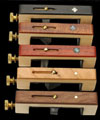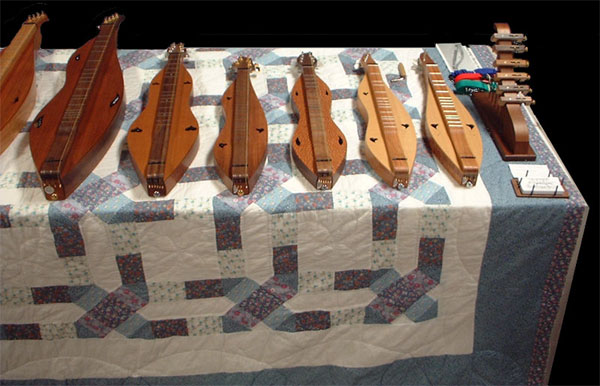INFORMATION

Frequently
Asked Questions Quick Links:
[Features]
[Options]
[Selecting
a Model]
[Dulcimer
Body Shapes]
[Dulcimer
Head Styles]
[Tuners]
[Soundholes]
[Baritone
Dulcimer]
[Dulcimettes]
[Ron
Ewing Capos]
[Straps]
[Hammer
Dulcimer]
[Orders]
Webpage Links:
[Home]
[Ordering] [Dulcimers]
[Dulcimettes]
[Hammer Dulcimer]
[Accessories]
[PriceList]
[Info]
[Email]
I have built and played about 1700 dulcimers since 1970 to date and can offer my customers the benefit of considerable experience as both a craftsman and a musician. I strive to build fine, attractive instruments at reasonable prices, in a variety of styles, and use only solid domestic and imported woods, selected for their tonal quality, beauty, and compatibility. I studied engineering and English Lit in college before I got the bug to build and play upon hearing a recording of the wonderful Richard and Mimi Farina. I apprenticed with Chet Hines - a retired civilian engineer by trade, and a builder and player of some renown in his later years. He grew up in southern Ohio and learned the craft from his grandfather. After a couple of years I took over production and built about 200 dulcimers for Chet before heading off on my own to study guitar building and develop my own mix of the traditional and modern.
As a
musician I have performed and taught throughout the country and am
particularly known for my lively renditions of traditional Irish,
Appalachian, and Euro dance tunes. I have guested on several
recordings, including Jerry Rockwell's wonderful, "The Blackbird and the
Beggarman." Most recently, I can be found playing the Irish slip jig
"Drops of Brandy" with Jerry Rockwell and Leo Kretzner on "Dulcimer
Celebrations" - a collection of live performances from Mountain
Dulcimer Week at Western Carolina University.
Features
include a 1.5" wide fretboard, an accurate
27.75" 15-fret scale - including numbers
6 1/2 and 13 1/2 - a fully compensated
bridge (usually only found on handmade guitars),
a zero fret/nut for consistent action and ease
of tuning, and precise Gotoh guitar tuners so
your instrument plays in tune, and tunes easily.
All instruments are hand-rubbed with a polyurethane
gel that produces a hard finish with a natural,
soft luster. Average dimensions are 35"
in length, 8" in width, and 2 1/4"
in depth (top to back, not including the fingerboard).
Unless otherwise specified, I set up my dulcimers
for D-A-D' tuning.
[ORDER
NOW]
[TOP]
Options include 3, 4, or 6 strings
(the latter in pairs), the 1/2, 1 1/2, and 8 1/2 frets for added
flexibility, fully chromatic fretboards, pickups, and a variety of
shorter or longer scales for small hands or particular needs. Full size
4 string models can be switched from double melody to equidistant
stringing.
[TOP]
Selecting a Model
involves choosing , woods, soundholes, a body shape, a head style,
tuners, and the number of strings. All else being equal, dulcimers with
spruce or cedar tops are louder and fuller than comparable instruments
with hardwood tops. I use spruce and western red cedar tops almost
exclusively for this reason, as modern players prefer a more
"guitar-like" sound. Western cedar tends to be mellower than spruce,
although the latter will "play in" and warm up with age and use. My
favorite combination for a warm, full sound and a beautiful dark look is
a figured mahogany back, cedar top, and walnut sides, head, and
fingerboard. There are many combinations of woods possible to give you
the look and sound you want, however. I also use cherry, various
maples, koa, lacewood, zebrawood, ebony, and various rosewoods - subject
to current availability. I am a custom builder and can build just about
anything you want and welcome a phone call to help you sort through the
decision process. Email works well for short questions and general
inquiries.
[TOP]
Body Shapes include the aorell,
hourglass, teardrop, and tearell. Hourglasses tend to fall on the
bright side of the sound spectrum; elliptical on the bass side, though
this will vary somewhat depending on the woods used and other
variables. The aorell falls somewhere in between with a really nice
balance to it. My favorite shape overall. The choice here is acoustic
as well as aesthetic. Let me know what sort of sound you are looking
for, and I'll do my best to accommodate you.
[TOP]
 Head Styles
include the F and S heads with left hand tuners,
for 3 and 4 string instruments, and the R, G,
and A heads for 4, 6, and 8 string models.
A lot of folks like the F and S heads for 3
and 4 string instruments, as the tuners fall
more readily to hand. They can also be reversed
for lefties. In the picture from left to right:
F, R, G, A, and S.
Head Styles
include the F and S heads with left hand tuners,
for 3 and 4 string instruments, and the R, G,
and A heads for 4, 6, and 8 string models.
A lot of folks like the F and S heads for 3
and 4 string instruments, as the tuners fall
more readily to hand. They can also be reversed
for lefties. In the picture from left to right:
F, R, G, A, and S.
[TOP]
Tuners used are Gotoh guitar machines
which are available in chrome, gold, or black
with matching position markers and strap buttons.
[TOP]
Soundholes include hearts,
trailing hearts, teardrops, crescents, shamrocks, seagulls, diamonds,
trailing diamonds, and various original designs.
[TOP]
When holding any dulcimer, always do so by the head and tail (like a baby) to avoid possible damage to the top. The soundhole area is particularly vulnerable.
Baritones
are
larger dulcimers with 29 1/2" scales, typically
tuned AEA' or GDG' below a standard dulcimer,
with a correspondingly bigger, deeper sound
- really majestic on slow tunes, and ballsy
like an Irish octave mandolin on flat-picked
reels and jigs. A true baritone is not
just a standard dulcimer with heavy strings
- you really need the longer string length,
bigger body, and altered bracing and bridge
to optimize the sound. They come in 3,
4, 6, and 8 string varieties, with average dimensions
about 2" longer than a standard dulcimer.
With a 1 1/2 fret they also have a larger variety
of chords for backup work than a typical DAD'
instrument. An interesting equidistant
4 or 8 string option is ADAD and variations
tuning (from low to high) that gives you more
range, mirroring an octave mandolin -
a baritone and standard combined in one instrument, with the
ability to remove one outside course or the
other, if you wish to play only 3 at a time.
I can also build DAD' instruments with this
scale length for a fuller sound and more
sustain.
[ORDER NOW]
[TOP]

Dulcimettes
are
small dulcimers that I designed back in 1975
as instruments suitable for backpacking,
ensembles, carseat playing and children. They
have a delightful mandolin-like sound that really
carries and are owned and played by a number
of top players. They are about 24"
long, 5" wide, and 1 1/2" deep, with
a 1 1/4" wide fretboard. They have 3, 4,
or 6 strings, 12 frets, Gotoh guitar machines, and are built with
the same woods and care as my full size instruments
- they aren't toys, in other words. They are
tuned to D-A-D' an octave above a standard dulcimer.
[ORDER
NOW]
Six String Dulcimettes
have a great full sound - sort of a cross between
a mandolin and a dulcimer - and are especially
nice for fiddle tunes, whether strummed or flatpicked.
They really cut and will hold their own in almost
any session. R, G or A head. Elegance
in miniature.
[ORDER
NOW]
Baritone Dulcimettes
are
tuned an octave above a full size baritone in
A or G with a 21" string length.
They average 27" long, 7" wide, 1
3/4" deep, with a 1 1/4" 13 fret fingerboard.
Six string models in G or A have
a great mandola-like sound with more sustain, and are wonderful
for fiddle tunes in these two popular keys.
I play one of these more than anything else
these days.
[ORDER
NOW]
[TOP]
 Ron Ewing Dulcimer Capos:
First on the market in 1975, and still the best. They just plain work! Capoing a
dulcimer is a quick and easy way to change keys and modes without
retuning, as well as having several advantages over the traditional
modal tunings. Much easier than retuning every time you want to change
keys or modes. You can't play everything in D, after all! They have a
maple body with a walnut or cherry overlay for extra strength, hard
rubber padding and clamp block, and a decorative brass dot and
thumbscrew. Specify wood and width of fingerboard with order. A
standard capo's adjustable range is 1 1/4 to 1 5/8", with custom
versions also available for unusually wide or narrow fingerboards.
Instructions for use, including a tuning/mode chart, are supplied with
the capo.
Ron Ewing Dulcimer Capos:
First on the market in 1975, and still the best. They just plain work! Capoing a
dulcimer is a quick and easy way to change keys and modes without
retuning, as well as having several advantages over the traditional
modal tunings. Much easier than retuning every time you want to change
keys or modes. You can't play everything in D, after all! They have a
maple body with a walnut or cherry overlay for extra strength, hard
rubber padding and clamp block, and a decorative brass dot and
thumbscrew. Specify wood and width of fingerboard with order. A
standard capo's adjustable range is 1 1/4 to 1 5/8", with custom
versions also available for unusually wide or narrow fingerboards.
Instructions for use, including a tuning/mode chart, are supplied with
the capo.
[ORDER
NOW]
Designer Capos: Same as above but with a pearl snowflake inlay on an ebony or one of various exotic overlays. A touch of elegance for your dulcimer.
[TOP]
 Straps
secure your dulcimer no matter what the seating,
and inspire confidence whether executing delicate
fingerstyle maneuvers or strumming jigs with
wild abandon. 1" nylon, made by Sue Carpenter
in a variety of colors; they are adjustable
and feature a quick release buckle for fast
exits. Highly recommended for dulcimettes, and
about the only ones that fit.
Straps
secure your dulcimer no matter what the seating,
and inspire confidence whether executing delicate
fingerstyle maneuvers or strumming jigs with
wild abandon. 1" nylon, made by Sue Carpenter
in a variety of colors; they are adjustable
and feature a quick release buckle for fast
exits. Highly recommended for dulcimettes, and
about the only ones that fit.
[ORDER
NOW]
[TOP]
Hammer Dulcimers:
12/11's and 15/14's. Birch plywood back;
redwood, cedar, or spruce floating top; hardwood
rails, trim, and bridges (walnut, cherry, exotic,
etc.), delrin bridge caps for ease of
tuning and reduced sustain, laminated pin blocks.
Soundholes include hearts, birds, ovals, shamrocks,
etc. All instruments include hammers, tuning
wrench, a lifetime guarantee, and the sort of
workmanship one would expect with 30 plus
years of experience. My instruments are light,
warm, and beautiful, with moderate sustain.
[ORDER
NOW]
[TOP]
Orders are accepted for a 50% deposit with the balance due upon completion, plus shipping and handling. For quicker service send the full amount. Delivery can usually be made in 3 - 6 weeks. Be sure to include a full description, number of strings and arrangement, tuning (if other than D-A-D') and any other particular requirements that you may have. I also try to keep a good selection on hand for those wishing to stop by and handpick an instrument. Simply call first, or catch me at one of the many festivals I do each year (see schedule). Thanks for visiting! Cheers, Ron.
Photography by markcheadle.com
[Home]
[Ordering]
[Dulcimers]
[Baritone]
[Dulcimettes]
[Hammer Dulcimer]
[Photo Gallery]
[Capos]
[Straps]
[Cases] [PriceList]
[Info]
[Schedule]
[Email]
[Ron
Ewing News]
Ron Ewing Dulcimers
224 East Maynard Avenue, Columbus OH, 43202
(614) 263-7246
ewing.ron@gmail.com

